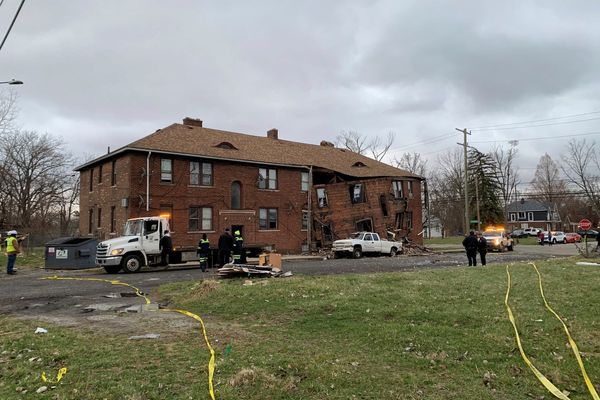
Amid the ruins of Palestinian villages destroyed by Israeli forces, life sprouts from the branches of newly-planted trees. While the Israeli government might suggest that this is nature reclaiming old habitat, much of this process is unnatural and predates the ongoing war in Gaza. Spaces formerly inhabited by Palestinians and their olive groves have been cleared by Israeli forces in many locations, and new trees — in many cases not native to the area — have been planted by the Jewish National Fund, a nonprofit founded in 1901 to develop land for Jewish settlement.
The Aleppo pine, for instance, is a fast-growing species found throughout the western Mediterranean, Greece and parts of the Levant, including northeastern portions of historical Palestine. But it has now become so widespread in Israel and Palestine that many environmentalists have blamed devastating wildfires on its unnatural proliferation. According to their research, the Aleppo pine's highly flammable leaves and cones have increased the risks of fire. Projects by Israeli nonprofits to introduce this species and other non-native trees, in other words, may not be conducive to their stated mission of "making the desert bloom."
Indeed, some scholars and activists critical of Israeli government policies — and especially of the military campaign that has killed at least 45,000 Palestinians in Gaza and displaced millions more — view these tree-planting projects as another weapon used by colonists against the native land and people.
"This idea of 'making the desert bloom,' along with denying access to food and water, releasing toxins in the air by bombing Gaza, is very much rooted in the old colonial logic of enacting indirect death and destruction," said Ameera Kawash, a Palestinian-Iraqi-American journalist. "This is part of a massive state-building project which is also rooted in greenwashing strategies and which goes back to the Nakba, the ethnic cleansing of 750,000 people [in 1948] and appropriation of four million acres of land. It's ecocide."
Ecocide is not an officially recognized crime under international law, as is genocide, but activists say its consequences can have similar consequences. Ecocide is defined by experts as a "wanton" act of destruction, carried out with "reckless disregard for damage which would be clearly excessive in relation to the social and economic benefits anticipated."
Island nations like Fiji, Samoa and Vanuatu have formally petitioned the International Criminal Court to consider ecocide a crime, and many experts draw parallels between the destruction of people and the destruction of nature, arguing that the latter is an integral part of achieving the former. In the case of the Israeli-Palestinian conflict, many scholars argue, the destruction and alteration of the natural environment not only deprives Palestinians of resources they need to survive, but also erases evidence of their historical existence or relegates it to the distant past.
During the course of the Nakba, the removal of Palestinians from their lands was accompanied by the renaming of sites and often by planting trees on the sites of villages, terraced fields and olive groves. In recreational forested parks that "bloomed" across what's now Israel, signs placed by the JNF elide or ignore the history of people who used to live there, pointing out apparently pristine natural wonders as if they existed for centuries.
"The true mission of the JNF ... has been to conceal these visible remnants of Palestine not only by the trees it has planted over them, but also by the narratives it has created to deny their existence," writes Israeli historian Ilan Pappe in "The Ethnic Cleansing of Palestine." "Whether on the JNF website or in the parks themselves, the most sophisticated audiovisual equipment displays the official Zionist story, contextualising any given location within the national meta-narrative of the Jewish people and Eretz Israel."
In all, Israeli forces destroyed an estimated 500 towns and villages during the 1948 conflict, along with perhaps 700,000 fruit and nut-bearing trees that were often replaced by the non-native pines. The tactics used at the time — deforestation and afforestation, cutting off water supplies, raids on Palestinian communities — are still being applied today, with the addition of 21st-century weapons and a far more sophisticated state apparatus. Forays by settlers and Israeli soldiers to uproot Palestinians' olive trees, both in Gaza and the occupied West Bank, have escalated dramatically in the wake of the Hamas attack on Oct. 7, 2023 that killed around 1,200 Israelis.
Since at least the early 20th century, the rhetoric behind the afforestation push in Israel/Palestine has implied that no existing human settlements or agriculture his been displaced or disrupted. Palestinian land was often described as "wilderness" or "desert," and the Zionist slogan "a land without a people for a people without a land," used as early as 1843, was entirely explicit. The idea that Jewish settlers were stepping into a mysteriously empty landscape, of course, was an ideological fiction: A 1922 British census counted a population of 757,182 people, of whom 83,794 were Jews.
The inhabitants of what was called "mandatory Palestine" encompassed urban residents, farmers with olive plantations and a population of Bedouin Arabs in the arid Negev desert (Naqab in Arabic). Now, Israeli authorities see the Negev as an enormous opportunity for large-scale afforestation.
Organizations like the JNF have long touted the environmental benefits of their projects — revitalizing the soil, reversing climate change through carbon capture, benefiting a diverse range of wildlife — especially in desert terrain long perceived as valueless. Noa Zer, a resource developer for the JNF, recalls on its official website standing in the Negev one day and looking east: She "saw the beautiful red mountains of Jordan, [but] beneath them I saw nothing but desert sand."
"This was the first time I realized what an enormous task it was to take a piece of desolated desert and turn it into a blooming oasis," Zer writes.
The Bedouin people of the Negev do not share that view. For them, the desert is home, where they cultivate date palms and raise herds of goats, sheep and camels. It is a landscape that inspires a rich poetic tradition, a forge that shapes cherished traditions and customs, and even a welcome refuge from troubling events beyond. It is not a blank canvas for outsiders to fill with ecology in their own image.
"From a colonial perspective, you want to project yourself," said Mazin Qumsiyeh, an environmental scientist who teaches at Bethlehem University and founded the Palestine Museum of Natural History. "You do that by bringing your superior civilization, your superior ecology, etc., to a savage country and a savage landscape.
"This is typical of all colonizers," Qumsiyeh continued. "They discover a place and destroy it and claim that they are greening it and that they are doing great things, when they have actually deforested it and changed courses of rivers and killed the local wildlife."
As JNF forestry workers began laying the groundwork for a new forest in August 2021, Israeli police helped clear the way by evicting people from their homes, which they then demolished. When Bedouin residents erected makeshift tents, the police ripped those down as well and threatened them with arrest. Under Israeli law, the police had done nothing wrong — the villages they destroyed were among 35 Bedouin communities "unrecognized" by the government, ostensibly because they were built without official authorization. In fact, most of those villages existed long before there was an Israeli state to grant them authorization.
The JNF's terraforming projects have, in a sense, never stopped, even if intense and concerted human effort has tapered off in some areas since 1948. In 1964, the JNF laid the first seeds for its crown jewel: the Yatir Forest, a 7,400-acre woodland of four million trees, largely Aleppo pines, that sits at the northern edge of the Negev near Hebron.
For that forest to prosper, many of the pre-existing flora and fauna have been decimated or exiled. According to a group of Israeli scientists interviewed by Yale 360 in 2019, the spreading tree cover is endangering plant species like the dark-brown iris, an endemic daffodil and remnant populations of a species of wild wheat. Native reptiles and birds, including the Be’er Sheva fringe-fingered lizard, the pin-tailed sandgrouse and the spectacled warbler, now fall easy prey for crows and jays perched in the tree branches. It also appears that the forests are not accomplishing the JNF's stated objective of reversing climate change, but actually retain heat that otherwise would be reflected back into space by the lighter colors of the Earth's surface.
Israeli afforestation is not limited to the state's internationally recognized boundaries. It's also taking place in the West Bank, where Israel has built dozens of illegal settlements and Palestinians are routinely arrested, harassed or evicted from their homes at gunpoint. According to the Akevot Institute, internal JNF documents from 1987 show that the organization has been planting in the West Bank for the express purpose of preparing the land for Jewish settlers and rendering it unusable for Palestinians seeking to return.
Since there may not be settlers available to move into a cleared-out area at a given moment, such areas are often designated as "state land" or "nature reserves" and reserved for future use. "In other words, afforestation was being used as a way of establishing ‘facts on the ground’ and taking over vast areas where no specific plans had been made yet, and no measures had been taken to secure control," the Akevot report said.
Such designations, as well as the physical presence of trees, concrete barriers and security personnel, often cut off Palestinian residents from other areas not under direct Israeli control. The fragmentation of remaining Palestinian land, organizations like the Palestinian Environmental NGOs Network say, has drastically reduced people's ability to sustain their livelihoods.
"It is much harder, even impossible, for Palestinians to feed their livestock, to reach areas where crops are grown that are important for their diet, or to even see family members," said Abeer Butmeh, an environmental engineer who works at PENGON. "The terraces that Palestinians used for agriculture are divided and wiped out. The goal of all this is to falsify the reality of Palestinian nature."
When Israeli Prime Minister Benjamin Netanyahu's government announced the walling-off of seven new so-called nature reserves in the West Bank in 2020, critics hardly needed to warn that it was a precursor to control and settlement — then-Defense Minister Naftali Bennett made the intent clear, declaring that the territory "belonged" to Israel and his goal was to annex it "within a short time." While the Israel Defense Forces never officially announced its occupation of those reserves, they acknowledge they have used them as military training sites.
The IDF is now embroiled in war both in Gaza and Lebanon, at enormous cost to civilian life. Early in November, Brig. Gen. Itzik Cohen announced that Palestinians who had fled northern Gaza would not be allowed to return even if their homes had not been destroyed, leading to another round of accusations that Israel was committing ethnic cleansing, including by Haaretz, the country's left-leaning newspaper.
For now, planting another forest where Gaza's villages and cities once stood seems like a distant possibility and an unimportant concern. But Israel's critics wonder that tactic will be used to erase the evidence of possible genocide.
Qumsiyeh, the professor at Bethlehem University, doesn't believe it will work. "There were hundreds of genocides and ecocides in human history before, but this one in Palestine sits at a fork in human history," he said. "We are in the 21st century. It's broadcast live, and it's seen. Nobody can deny it."







